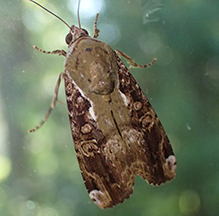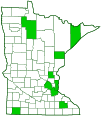orbed narrow-wing
(Magusa divaricata)
Conservation • Description • Habitat • Ecology • Distribution • Taxonomy
|
||||||||
| Hodges # | 9637.1 |
|||||||
Conservation Status |
||||||||
| IUCN Red List | not listed |
|||||||
| NatureServe | NNR - Unranked SNR - Unranked |
|||||||
| Minnesota | not listed |
|||||||
Description |
||
Orbed narrow-wing, also called variable narrow-wing, is an uncommon, migratory, medium-sized moth. It occurs from southern Canada to central South America. Orbed narrow-wing adults fly year-round as far north as Texas. They migrate northward every year, bypassing the middle latitudes of the United States. They arrive in Minnesota usually in August or September. They do not migrate south again in the fall, and they do not survive northern winters. Their long-distance migration results in two distinct, widely separated ranges in the U.S. In the northeast they occur from Maine to New Jersey, west to Minnesota and northern Illinois. In the southwest they occur from Texas to eastern Arizona. Between these ranges there is a sprinkling of widely scattered records. Their northern range appears to be expanding, possibly due to the expanding range of their preferred northern host, glossy buckthorn. Orbed narrow-wing larvae feed on Carolina buckthorn, glossy buckthorn, and possibly other plants in the Rhamnaceae (buckthorn) family. In Minnesota, adults are active from August to October in shrubby areas that contain buckthorn. Adults are 11⁄16″to ⅞″ (18 to 22 mm) in length and have a 1 5⁄16″ to 1¾″ (33 to 45 mm) wingspan. Moth size is sometimes given in terms of forewing length, which in this case is ⅝″ to ¾″ (15 to 22 mm). The body is long and slender. The head is prominent. The sensory mouthparts (labial palps) are turned upward and are short, reaching to the middle of the head. The forewing is long and narrow, three times longer than wide. The outer margin is rounded and is strongly angled toward the inner margin. The coloration is highly variable. The background color is chocolate brown, brownish gray, or blackish brown. The inner half is often a contrasting pale gray or brown. On some individuals, there is a thin, white, longitudinal line in the basal area. The circular spot (orbicular spot) in the upper median area is large, and it is placed lower than usual. The kidney-shaped spot (reniform spot) in the lower median area is large. Both spots are usually conspicuous, usually hollow or pale inside, and always bordered with a narrow black line. The reniform spot is usually also surrounded with an outer, narrow, whitish line. The antemedial (AM) line is scalloped and almost touches the orbicular spot. The postmedial (PM) line is strongly bent upward toward the leading edge (costal margin). Both lines are inconspicuous. There is usually a large, pale, more or less round patch on the costal margin near the wingtip. The hindwings are a medium to dark shade of the forewing base color. They are somewhat translucent between the veins. |
||
Size |
||
Total length: 11⁄16″to ⅞″ (18 to 22 mm) Wingspan: 1 5⁄16″ to 1¾″ (33 to 45 mm) |
||
Similar Species |
||
Habitat |
||
shrubby areas that contain buckthorn |
||
Ecology |
||
Season |
||
August to October |
||
Behavior |
||
Adults are active at night and will come to lights. |
||
Life Cycle |
||
|
||
Larva Food |
||
Carolina buckthorn, glossy buckthorn, and possibly other plants in the Rhamnaceae (buckthorn) family |
||
Adult Food |
||
|
||
Distribution |
||||
|
Sources Records of Magusa orbifera in the United States north of southern Florida prior to 2009 should be considered as to referring to Magusa divaricata. |
|||
| 12/12/2023 | ||||
Occurrence |
||||
Uncommon |
||||
Taxonomy |
|||
Order |
Lepidoptera (Butterflies and Moths) | ||
Superfamily |
Noctuoidea (Owlet Moths and Allies) | ||
Family |
Noctuidae (cutworm moths and allies) | ||
Subfamily |
Noctuinae (cutworms and dart moths) | ||
Tribe |
Dypterygiini | ||
Genus |
Magusa | ||
Magusa divaricata was formerly treated as a synonym of Magusa orbifera. It was raised to full species status in 2009. The two species can be reliably differentiated only by microscopic examination of the male genitalia and by location. Magusa orbifera occurs only as far north as southern Florida. |
|||
Synonyms |
|||
Magusa dissidens Magusa sarpida Stictoptera divaricata |
|||
Common Names |
|||
orb narrow-wing moth orbed narrow-wing orbed narrow-wing moth variable narrow-wing |
|||
Glossary
Antemedial (AM) line
A thin line separating the basal area and the median area of the forewing of Lepidoptera.
Costal margin
The leading edge of the forewing of insects.
Orbicular spot
A circular spot or outline in the upper median area near the antemedial line on the forewing of many moths.
Palp
Short for pedipalp. A segmented, finger-like process of an arthropod; one is attached to each maxilla and two are attached to the labium. They function as sense organs in spiders and insects, and as weapons in scorpions. Plural: palpi or palps.
Postmedial (PM) line
A thin line separating the median area and the postmedial area of the forewing of Lepidoptera.
Reniform spot
A kidney-shaped spot or outline in the lower median area near the PM line on the forewing of many moths.
Visitor Photos |
|||||
Share your photo of this insect. |
|||||
| This button not working for you? Simply email us at info@MinnesotaSeasons.com. Attach one or more photos and, if you like, a caption. |
|||||
Babette Kis |
|||||
Magusa divaricata orbed narrow-wing moth Magusa divaricata, orbed narrow-wing moth, Milwaukee, WI. The caterpillars eat buckthorn. Photo was taken on Sept. 17, 2021. |
 |
||||
MinnesotaSeasons.com Photos |
|||||
|
|||||

Slideshows |
||

Visitor Videos |
|||
Share your video of this insect. |
|||
| This button not working for you? Simply email us at info@MinnesotaSeasons.com. Attach a video, a YouTube link, or a cloud storage link. |
|||
Other Videos |
|||


Created: 12/13/2023
Last Updated:

